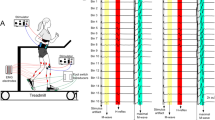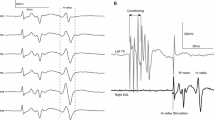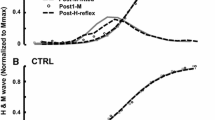Abstract
The stability of the maximal muscle response (Mmax) is critical to H reflex methodology. It has previously been reported that the amplitude of Mmax declines over time. If reproducible, this finding would have implications for all experimental studies that normalise the output of the motoneurone pool against the M wave. We investigated the effect of time on changes in Mmax and the maximal H reflex (Hmax) evoked at 4-s intervals over 60 min. To identify an influence of homosynaptic depression, we extended the interstimulus interval to 10 s and the time to 100 min. Two recording montages over soleus were used to ensure that interelectrode distance was not a critical factor. The soleus Mmax and H reflex were evoked by stimulation of the tibial nerve in the popliteal fossa in 7 subjects who sat with the knee flexed to 30° and the ankle plantar flexed by ~30°. We found no change in the pooled data for Mmax, Hmax, a reflex 50% of maximal, or the current required to produce it. However, one subject had a statistically significant increase in Mmax and a concurrent decrease in Hmax regardless of the interstimulus interval. On average, there was no change in the Hmax/Mmax ratio over time. While both Mmax and Hmax may change in response to many factors, these results suggest that, typically, time is not one of them.



Similar content being viewed by others
References
Allen GM, Gandevia SC, McKenzie DK (1995) Reliability of measurements of muscle strength and voluntary activation using twitch interpolation. Muscle Nerve 18:593–600
Angel RW, Hofmann WW (1963) The H reflex in normal, spastic, and rigid subjects. Arch Neurol 9:591–596
Bathien N, Morin C (1972) Comparing variations of spinal reflexes during intensive and selective attention. Physiol Behav 9:533–538
Bigland-Ritchie B, Jones DA, Woods JJ (1979) Excitation frequency and muscle fatigue: electrical responses during human voluntary and stimulated contractions. Exp Neurol 64:414–427
Bigland-Ritchie B, Furbush F, Woods JJ (1986) Fatigue of intermittent submaximal voluntary contractions: central and peripheral factors. J Appl Physiol 61:421–429
Bromberg MB, Spiegelberg T (1997) The influence of active electrode placement on CMAP amplitude. Electroencephalogr Clin Neurophysiol 105:385–389
Brunia CH (1971) The influence of a task on the Achilles tendon and Hoffmann reflex. Physiol Behav 6:367–373
Calder KM, Hall LA, Lester SM, Inglis JG, Gabriel DA (2005) Reliability of the biceps brachii M-wave. J Neuroeng Rehabil 2:33
Christie AD, Inglis JG, Boucher JP, Gabriel DA (2005) Reliability of the FCR H-reflex. J Clin Neurophysiol 22:204–209
Crone C, Hultborn H, Mazieres L, Morin C, Nielsen J, Pierrot-Deseilligny E (1990) Sensitivity of monosynaptic test reflexes to facilitation and inhibition as a function of the test reflex size: a study in man and the cat. Exp Brain Res 81:35–45
Crone C, Johnsen LL, Hultborn H, Orsnes GB (1999) Amplitude of the maximum motor response (Mmax) in human muscles typically decreases during the course of an experiment. Exp Brain Res 124:265–270
Cupido CM, Galea V, McComas AJ (1996) Potentiation and depression of the M wave in human biceps brachii. J Physiol 491:541–550
Delwaide PJ (1973) Human monosynaptic reflexes and presynaptic inhibition. An interpretation of spastic hyperreflexia. In: Desmedt JE (ed) New developments in electromyography and clinical neurophysiology. Karger, Basel, pp 508–522
Eccles JC, Rall W (1951) Effects induced in a monosynaptic reflex path by its activation. J Neurophysiol 14:353–376
Fuglevand AJ, Zackowski KM, Huey KA, Enoka RM (1993) Impairment of neuromuscular propagation during human fatiguing contractions at submaximal forces. J Physiol 460:549–572
Funase K, Miles TS, Gooden BR (1999) Trial-to-trial fluctuations in H-reflexes and motor evoked potentials in human wrist flexor. Neurosci Lett 271:25–28
Garland SJ, Gerilovsky L, Enoka RM (1994) Association between muscle architecture and quadriceps femoris H-reflex. Muscle Nerve 17:581–592
Goulart F, Valls-Sole J, Alvarez R (2000) Posture-related changes of soleus H-reflex excitability. Muscle Nerve 23:925–932
Hicks A, Fenton J, Garner S, McComas AJ (1989) M wave potentiation during and after muscle activity. J Appl Physiol 66:2606–2610
Hoehler FK, McCann MA, Bernick DL (1981) Habituation of the Hoffmann reflex. Brain Res 220:299–307
Ismail HM, Ranatunga KW (1978) Isometric tension development in a human skeletal muscle in relation to its working range of movement: the length-tension relation of biceps brachii muscle. Exp Neurol 62:595–604
Jaberzadeh S, Scutter S, Warden-Flood A, Nazeran H (2004) Between-days reliability of H-reflexes in human flexor carpi radialis. Arch Phys Med Rehab 85:1168–1173
Katz B (1939) The relation between force and speed in muscular contraction. J Physiol 96:45–64
Lin CS, Chan JH, Pierrot-Deseilligny E, Burke D (2002) Excitability of human muscle afferents studied using threshold tracking of the H reflex. J Physiol 545:661–669
McComas AJ, Galea V, Einhorn RW (1994) Pseudofacilitation: a misleading term. Muscle Nerve 17:599–607
McNulty PA, Jankelowitz SK, Wiendels TM, Burke D (2008) Postactivation depression of the soleus H reflex measured using threshold tracking. J Neurophysiol 100:3275–3284
Meinck H-M (1980) Facilitation and inhibition of the human H reflex as a function of the amplitude of the control reflex. Electroencephalogr Clin Neurophysiol 48:203–211
Nandedkar SD, Barkhaus PE (2007) Contribution of reference electrode to the compound muscle action potential. Muscle Nerve 36:87–92
Pierrot-Deseilligny E, Burke D (2005) The circuitry of the human spinal cord. Its role in motor control and movement disorders. Cambridge University Press, Cambridge
Pierrot-Deseilligny E, Mazevet D (2000) The monosynaptic reflex: a tool to investigate motor control in humans. Interest and limits. Neurophysiol Clin 30:67–80
Rutkove SB (2000) Pseudofacilitation: a temperature-sensitive phenomenon. Muscle Nerv 23:115–118
Schneider C, Lavoie BA, Capaday C (2000) On the origin of the soleus H-reflex modulation pattern during human walking and its task-dependent differences. J Neurophysiol 83:2881–2890
Søgaard K, Gandevia SC, Todd G, Petersen NT, Taylor JL (2006) The effect of sustained low-intensity contractions on supraspinal fatigue in human elbow flexor muscles. J Physiol 573:511–523
Stephens JA, Taylor A (1972) Fatigue of maintained voluntary muscle contraction in man. J Physiol 220:1–18
Weir DE, Tingley J, Elder GC (2005) Acute passive stretching alters the mechanical properties of human plantar flexors and the optimal angle for maximal voluntary contraction. Eur J Appl Physiol 93:614–623
Acknowledgments
This study was supported by the National Health and Medical Research Council of Australia and the Office of Science and Medical Research, New South Wales.
Conflict of interest
The authors declare that they have no conflict of interest.
Author information
Authors and Affiliations
Corresponding author
Rights and permissions
About this article
Cite this article
McNulty, P.A., Shiner, C.T., Thayaparan, G.K. et al. The stability of Mmax and Hmax amplitude over time. Exp Brain Res 218, 601–607 (2012). https://doi.org/10.1007/s00221-012-3053-4
Received:
Accepted:
Published:
Issue Date:
DOI: https://doi.org/10.1007/s00221-012-3053-4




